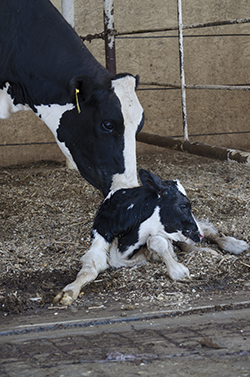 A cow that's come down with milk fever is easily recognizable. Oftentimes, the cow, unable to stand, has its head against its side, and its ears are cold to the touch. This metabolic disease has long plagued our transition cows, but, over time, we have developed and implemented strategies to lessen its prevalence.
A cow that's come down with milk fever is easily recognizable. Oftentimes, the cow, unable to stand, has its head against its side, and its ears are cold to the touch. This metabolic disease has long plagued our transition cows, but, over time, we have developed and implemented strategies to lessen its prevalence. While the cow exhibiting clinical signs of disease clearly requires our intervention, a more serious threat may lurk among its seemingly normal herdmates. Subclinical hypocalcemia lies below our visual detection threshold. But, there may be opportunities to intervene here, as well.
On an 8,000-cow dairy in California, researchers with the University of California-Davis evaluated calcium dynamics in the cow after preventative oral or intravenous (IV) calcium treatments were administered. For the study, 33 multiparous Jersey-Holstein crossbred cows were assigned to one of three treatments: no calcium supplementation, IV-calcium or oral calcium.
Total serum calcium was evaluated at 11-time points from the initiation of treatment to 48 hours later. Total serum calcium levels were higher for IV cows than control or oral cows in the 4 hours after treatment. This situation reversed later, though, as orally treated cows had a better calcium status 20, 24 and 36 hours out. At 36 and 48 hours, control cows also had a better calcium status compared to IV-treated cows.
Wide fluctuations in blood calcium were observed after preventatively administering IV calcium. An hour after treatment initiation a greater proportion of IV animals had calcium levels over 10 mg/dL compared to the other treatments. IV cows' calcium status descended quickly; at 24 hours after treatment initiation, these cows reached their calcium low point at levels well under 8 mg/dL.
For the first 24 hours, cows given an oral supplement tended to have calcium levels 0.35 mg/dL above those in the control group. Data from an earlier study conducted by Gary Oetzel, from the University of Wisconsin School of Veterinary Medicine, indicated that oral supplementation efforts may be best targeted to high-producing or lame cows.
To prevent clinical and subclinical milk fever, some herds may benefit from implementing preventative strategies. Further research is needed to evaluate the milk production and animal health implications these changes in serum calcium may have.

The author, Amanda Smith, was an associate editor and an animal science graduate of Cornell University. Smith covers feeding, milk quality and heads up the World Dairy Expo Supplement. She grew up on a Medina, N.Y., dairy, and interned at a 1,700-cow western New York dairy, a large New York calf and heifer farm, and studied in New Zealand for one semester.








